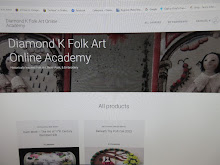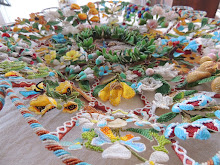Spring ...Sprung...Sprang????
So why would you care for the difference between 'Sprang' and knotting, or netted work? From a buyers point of view, cost is absolutely the reason. Sprang examples are exceedingly rare, since they can unravel like knitting....and so, are much more costly than knotted pieces~ tho many knotted pieces are passed off as Sprang to those who are unaware of what they are looking at. Sprang is a method of twisting the warp threads together to make a very flexible fabric that has a great ability for expansion. The warp threads are fixed at both ends on a frame, and then twisted in a way that can interlink, interlace or intertwine them....the threads are twisted...not knotted. There are no knotts in Sprang woven pieces. We will look first at the purse on the bottom, the knotted purse...as an example of what Sprang is not. Click on the photo above and you will see the mesh is made up of both small and elongated diamonds....and where each and every single thread meets, is a knot.
Pieces that are made of a knotted netting, can still survive with holes, as seen above. With a knot at each juncture, the piece will not hopelessly unravel
Without a loupe or high magnification, one could mistake this pattern of netting for same pattern in the Sprang technique, as seen above...but note, the Sprang is again twisted....there are no knots.
Now we can look at the Sprang purse. In both this case, and with the purse above, the design in the finished mesh is dictated by both the weave, and the dye of the thread~ just like modern day 'sock yarn'~ as one knits a sock, colored patterns will appear as one knits along. Its hard to see in ts example~if you go back up to the first closeup of the knotted purse, and look at the elongated diamonds, you can see where the color of the thread changes inbetween the knots.
This purse has been worked in fine silk, and when it gets a hole, there is nothing to keep it from unraveling, which is why I dont dare spread or put tension on the weave. There are are many different, very complicated weave patterns of Sprang~
I highly recommend 'The techniques of Sprang by Peter Collingwood' if you desire to read further or would like to learn how to do it for yourself.




























No comments:
Post a Comment